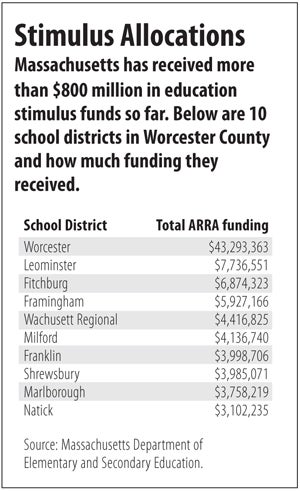School Districts Face Funding Cliff | Stimulus dollars help plug holes, but local CFOs are predicting major shortfalls

When federal education officials made stimulus money available to states earlier this year, the intent was to save jobs, supplement education funding and create new, innovative programs for local school districts.
The intention was not to cut education funding and replace it with American Recovery and Reinvestment Act funds, which is exactly what the federal Department of Education Inspector General’s office criticized Massachusetts as well as two other states for doing. And while the head of the DOE recently came out reversing the inspector’s report and finding no fault with the state of Massachusetts, local school districts are still in a tough spot.
That’s because by next fiscal year the stimulus money, which was suppose to last through 2011, is expected to run out.
“We’re facing a funding cliff,” said Brian Allen, chief financial officer for the Worcester Public Schools.
Jonathan Palumbo, spokesperson for the state Executive Office of Education, said education officials submitted their plan to use stimulus funding to make up revenue shortfalls to the federal Department of Education for review.
“We explicitly outlined how we would apply the stimulus money, and it was approved,” Palumbo said. “For them to come back later and say we don’t like what you’re doing is a little odd.” The state submitted an official written complaint in regards to the inspector’s report and got a mea culpa from the federal agency on Nov. 1.
Big Money
While the state’s squabble with the feds seems to have been resolved, school districts are facing real financial worries. Worcester, with a nearly $300 million school budget, has received about $43 million in stimulus money so far through the American Recovery and Reinvestment Act.
When the city’s Chapter 70 funding, which is the main source of state aid for education, was cut almost $19 million last year, state officials instructed districts to use stimulus money to make up whatever amount they had been cut. That allowed jobs and programs that would have been cut to be saved.
“It has essentially postponed the effect of the recession on us, at least for another year,” Allen said.
Using stimulus money to backfill, or make up revenue shortfalls, is permissible under the ARRA program, as long as the state does not cut below education funding levels from fiscal year 2006.
Massachusetts, however, facing severe revenue shortfalls last fiscal year, was forced to cut education funding, even below the FY06 levels.
The state applied for a waiver from the federal government, arguing that while the funding levels are dipping below the 2006 levels, the state is still spending as much on education as a percent of the overall state revenues as the year before.
Some school superintendents said the state had no choice but to make up revenue shortfalls with stimulus funding. (Click here to see which Central Massachusetts school districts have received the most funding.)
“I know (the federal government) was looking for us to create some innovative programs (with stimulus funds),” said Leominster Superintendent Nadine Binkley. “But really, school systems are more in a survival mode. Much of the money from the stimulus has gone to save existing jobs and programs.”
Leominster has received $7.7 million in stimulus funding during the past two years.
Shrewsbury Superintendent Joseph Sawyer said if stimulus funds were not used to plug holes left by revenue shortfalls, districts would have been scrambling to close multi-million dollar gaps in their fourth quarter of last fiscal year.
“It would have left school districts in an incredibly difficult position if they had not provided funding to back up the cuts,” Sawyer said. “You can’t fault the state for trying to keep things afloat.”
Shrewsbury received almost $4 million in stimulus funds.
Sawyer said it’s unclear what will happen for the rest of this fiscal year and next.
Continuing revenue shortfalls at the state this year could mean midyear cuts in the coming weeks or months.
Sawyer said district school committees across the state could have to make difficult decisions and decide if they will elect to use additional stimulus funding to offset possible mid-year cuts.
If that is done, stimulus money will be spent even faster, leaving even less stimulus funds for next fiscal year’s budget.
Sawyer said he’s trying to avoid the “funding cliff” by spending stimulus money on programs that will create efficiencies within the district.
For example, he has hired two co-teaching special education teachers. That program will allow special education students who would have been placed out of district at a cost to Shrewsbury to remain in regular education classrooms.
Sawyer said the money the district will save from not having the students placed out of district should be able to pay for the salaries of the two new teachers even if stimulus funding dries up sooner than expected.









0 Comments